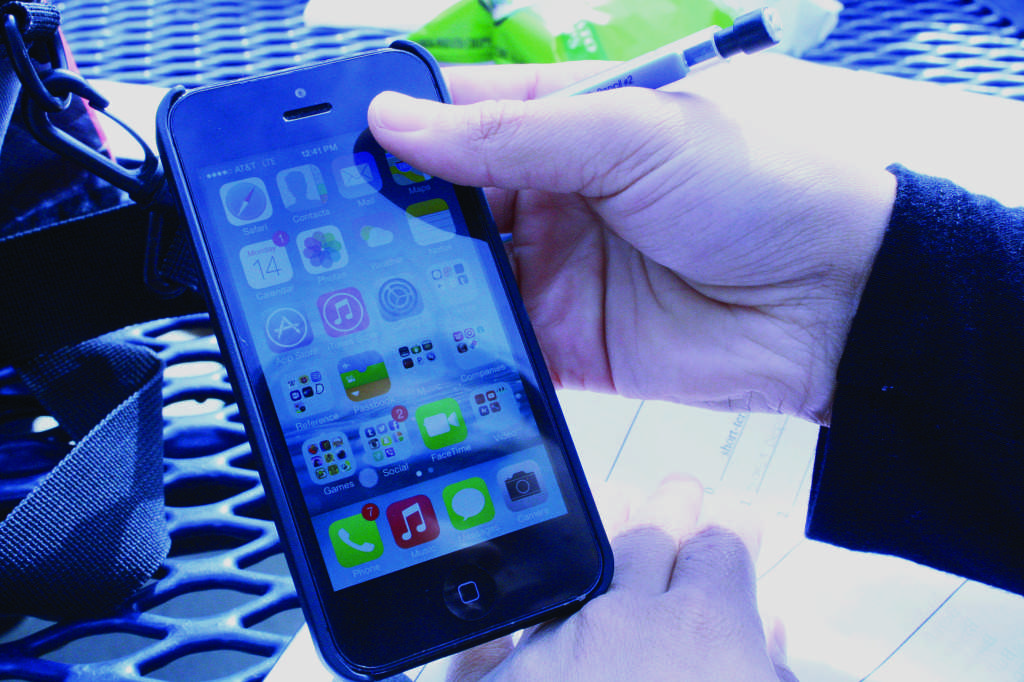Sexting: The Fine Line
October 30, 2013

I. “One day [at Clayton] I was walking down the hall and someone was like, Oh, look at that, that’s that whore in the picture.”
This is just one facet of the tirade of responses that assaulted Rachel*, a CHS student whose name has been changed to protect her anonymity, after a sexual picture of her was shared without her consent.
Rachel was at a party with her friends when the picture was taken. Many of the boys at the party had been pressuring her to drink all night, and she soon found herself in a compromising position with two other people. Suddenly, someone pulled their phone out.
“[A picture] was taken of me without my consent, and I asked if it could be deleted. They said it was and it would never go anywhere, and then it was sent to everyone in their school, and our school and St. Louis,” Rachel said.
In a few days, the photograph had spread to schools across the city.
As she watched the picture get sent to an increasing number of people, Rachel lost more and more control of the situation. She faced several insults and attacks such as the one she experienced in the halls of CHS, and she felt as though there was no way to defend herself against them.
“Everyone just assumed that I was okay with it and I wanted it sent around. No one knew that it was not okay with me,” Rachel said.
Rachel was embarrassed and angry. But most of all, she felt taken advantage of.
While Rachel partially blamed herself for getting into the situation where the picture could be taken, she ultimately felt that the boys who had shot and shared the photo were responsible for its spread.
“[The boys there] had us [drink] but they didn’t, so I was already not in a good position, and then they just ran in and took a picture of what was going on. Then when I asked them to delete it they didn’t. So I feel like it was kind of my fault for doing what they said, but also it’s not like I didn’t try to stop it,” Rachel said.
Rachel didn’t tell her parents, teachers or the police because she feared the backlash that would come from the presence of alcohol in the photograph. She also felt that since there were so many people involved in the spread of the picture it would be impossible to ever stop.
Eventually, the sharing of the picture slowed and it gradually faded from conversation.
However, Rachel still knows that the picture exists throughout the city and that it could resurface and do more harm at any moment.

II. Elizabeth*, a CHS student, regularly shares sexual images and messages with her boyfriend.
“With my boyfriend I feel like I can trust him and he wouldn’t use it against me, so I have not regretted it,” Elizabeth said.
Elizabeth and her boyfriend are in a long-distance relationship, which was part of what led Elizabeth to begin sexting.
“There definitely can be dangers to [sexting], but I think it can also be something that’s healthy for a relationship, especially a long-distance thing,” Elizabeth said.
Elizabeth believes that sexting is safe and okay to partake in as long as it is with someone whom you are committed to.
“I think it can be very risky, because it can come back to hurt you if you don’t really trust the person and the person isn’t someone that cares about you, Elizabeth said. “If it’s just someone that you’re casually sexting, it can be blackmailed, it can be shared.”
Elizabeth had been wary of sexting for fear that the pictures would somehow be seen by others without her consent if they were sent through normal messaging systems. However, with the advent of Snapchat, Elizabeth found a medium that seemed to promise her a safe way to send pictures without outside discovery.
Snapchat allows users to send a picture with a short message attached. Once opened by the receiver, the picture can be viewed for an amount of time set by the sender (with a maximum of ten seconds) before it then disappears from the receiver’s phone. Although the pictures can be captured through screenshots, Snapchat does alert the receiver if the picture has been screenshotted.
It made me more comfortable; whether that’s good or bad I don’t know, Elizabeth said.
Elizabeth recognizes the dangers of sexting, but the precautions that she takes, being in a committed relationship, using Snapchat, make her feel safe when sexting.
I think there’s good and bad to it,” she said. “There needs to be a balance of being OK and not shameful about it but also being safe and knowing the consequences of what you’re doing.”
III. Julia*, another CHS student, received a picture of a friend’s genitals completely without her consent or invitation.
Julia was exercising with friends when the boy sent the picture through Snapchat. Unaware of the contents, Julia casually opened the picture.
“I was shocked by what came up on my screen, and I was also embarrassed for the people around me because they had to see [the picture] as well, so it just came up during a very public time,” Julia said.
Julia immediately began texting the boy to tell him not to send her a similar picture again, but she was interrupted by another Snapchat.
“Before I could send that message right after the snapchat, I got a second [sexual picture],” Julia said.
After receiving the second picture, Julia told the boy not to try to contact her again.
“I have a really high respect for myself and so, when I got that Snapchat, it felt sort of degrading to me and I felt disrespected … some people may think that’s an overreaction, but that’s how I felt … I was just not okay with it,” Julia said.
Not only was she insulted by the boy’s affronts, but Julia felt like the friendship she had with the boy was completely altered after viewing the picture.
“I’m never really going to think of him or feel the same way about him as I did before, I’m always going to have that image hanging over me,” Julia said.
As offended and hurt as Julia was when she received the picture, she felt that it was important that she went through it so that she could be prepared for similar occurrences.
“I feel like it opened my eyes, and I feel like it was a good experience to have to go through, because it makes you more cautious and more wary of what happens in the future,” Julia said.

IV. These stories are the sobering reality of sexting. They represent three parts of the spectrum of sharing sexual images online: having pictures shared without one’s consent, receiving pictures without consent and sending them willingly.
While these three stories are from the Clayton High School community, they are in no way unique.
The sexting craze has most recently appeared to the public eye in the widely-known Steubenville High School rape case, in which a young, intoxicated girl was raped by two classmates while she was passed out at a party. Pictures and descriptions of the rape were posted across social media by the boys and texted to several people.
Highly-publicized sexting cases such as this only represent the tip of the iceberg in the sexting epidemic currently sweeping the nation, a practice which manifests itself through mediums such as Facebook, Snapchat, text messaging and dozens of other systems.
In America, 20 percent of teens are reported as having posted or sent a naked picture of themselves.
The punishment for teenagers sending sexual photos of themselves or others varies from state to state.
Missouri’s laws are some of the more relaxed in the nation, but the consequences can still be crushing to those convicted.
Upon their first conviction, minors who have shared sexual images – an act which constitutes child pornography in the eyes of the law – are guilty of a Class A misdemeanor. This means that perpetrators can receive up to one year in jail or up to a $1000 fine. However, they will not have to register as sex offenders, unlike guilty teens in several other states.
If the teenager is convicted of sharing sexual images a second time, then they can be punished with a Class D felony. This can merit up to four years in jail or a fine of up to $5000.
Those above 18 under the current Missouri laws, however, can be served a Class D felony upon their first conviction of spreading sexual images, which could include them having to register as a sex offender.
These consequences represent a 2009 change of Missouri’s laws. Before then, teenagers caught sharing sexual images , considered child pornography, could be convicted of a felony and had to register as a sex offender.
As the number of teenagers participating in sexting, and the number of teenagers being convicted for related crimes, increases, the leniency of these laws can be both a blessing and a curse.
Rebecca Biermann, a detective with Washington University in St. Louis who used to work with a St. Louis area task force that addressed all Internet exploitation of children, reflected this dual purpose in the law.
“I think there’s a fine line there in the laws where you want to teach kids a lesson, but you don’t want to ruin their lives,” Biermann said.
V. Biermann has seen dozens of cases involving sexting and other digital sex crimes throughout her career. As the breadth and reach of technology expands, Biermann observes the abuse of such technology enlarging with it. The growing sophistication of technology makes it increasingly difficult for task forces like Biermann’s to convict people of child pornography and sexting.
“We don’t have the technology yet to covertly discover what they’re doing on apps, because apps are independently made. So it’s very hard for us to get into those systems, whereas with a big site like Facebook or MyYearbook, they have their own security people who are watching that anyway, so they’ll catch the stuff and send it to [the police],” Biermann said.
Snapchat marks the most insidious branch of technology when it comes to sexting. Championing its ability to protect the privacy of its users, thousands of teenagers have flooded to Snapchat since its creation in September 2011.
However, the safety that teenagers feel when using Snapchat, especially to spread sexual images, may be founded in false promises.
“Snapchat has a big advertisement that [a sent picture] just disappears, and in reality it doesn’t. It’s stored locally, and it’s stored on the servers in which they traffic,” Gene Gladstone, CHS educational technology assistant, said.
If pictures sent through Snapchat don’t disappear, then users like Elizabeth could face severe ramifications for sexual pictures shared through Snapchat down the road.
“There is always a digital trail on everything we do, even if we think it disappears. Somebody who’s talented enough or people who have the resources can always make those digital bits and bytes come back to life,” Gladstone said. “If they’re there, they can be found, and if they can be found, they can do damage.”
While there’s a chance that “Snapchatted” pictures might harmlessly fade away, the possibility of them resurfacing could be disastrous for millions of users.
VI. Rachel still thinks about that night, the days that followed, and what she could have done differently to prevent such a degrading outbreak.
“I feel like it would have helped [to report it], but so many people had seen it already, and so many people knew about it, and so many people had it that it just would have gotten so many people in trouble, and I would have looked really bad,” Rachel said.
Although it’s comforting for teenagers to think that mistakes can be resolved and retracted, the pernicious nature of the sexting epidemic lies in the immense difficulty of doing so.
Gladstone emphasizes the digital imprint that human beings, especially teenagers, make in their everyday lives.
“Any time you use a device, and especially if you’re accessing the Internet, you leave a trail. And the kind of things that people typically think are, ‘I can delete my history,’ and you eliminate that trail. But that trail is always going to exist; it’s just a matter of whether or not the suspected violation is so severe that you need to invest the time and talent to go back and follow that trail,” Gladstone said.
While the police can take certain punitive measures after the private pictures have been sent and tears have been shed, lives will still be at the mercy of what is forever embedded in the vast workings of cyberspace.
“Any time you use social media to post anything about yourself or somebody else, you need to presume it’s going to be there forever and you need to assume that, when you graduate high school and you look to enroll in college or… to choose a job, people are going to want to go back and take a look and see just who you were in high school,” Gladstone said.
As someone who followed the digital trails of suspected criminals professionally, Biermann believes that the legal aspect of the epidemic has become increasingly convoluted due to the fact that so many of these confessed distributors of child pornography are merely children themselves.
“You can’t be charged with a felony, you don’t have to be registered as a sex offender, and so I think that just shows people that it’s not that big of a deal. Then again, there are kids where you don’t want to ruin their lives just because they sent a picture of themselves to their boyfriend or girlfriend and it got out of control,” Biermann said.

VII. Teenagers of the next generation have developed an unprecedented symbiosis with the technology industry. Adolescents are an intrinsic part of technology’s expansion, and technology has become an inherent part of adolescent lives.
Although this relationship between teens and technology may prove beneficial in the future, it currently presents inevitable dangers.
Teenagers are irrefutably the most reckless, mistake-prone and hormone-driven people. Combine these traits with the most intelligent and permanent medium of communication ever known, and therein lies an immense problem of a concerning magnitude.
While there may never be a solution to the raging adolescent hormones and sexuality of teenagers, the exploitation of minors on social media and cell phones can be prevented. However, this prevention depends on a commitment to providing teenagers with the information necessary to make informed decisions about sharing sexual content through technology.
Educating teenagers about life choices is notoriously difficult. Rather than giving up due to the sheer difficulty of the task, parents need to reveal what really lurks within such a deceptively intimate device.
The level of surveillance that parents decide to use is ultimately their decision, but an openness to discuss the consequences of using such a prevalent medium of communication for the most private facet of our lives is mandatory.
“You have to make it real, put it on the table for them, and kind of hope for the best,” Biermann said.
Outside of the home, companies within the social media and technology industry must take exhaustive steps toward preventing the spread of explicit images of minors. While certain companies do monitor the images that are sent and received on their sites, there are still private companies, such as Snapchat, that seem as though they are purposely providing teenagers a medium to exchange these images.
What is even more counterproductive is that these companies are convincing minors that their pictures are forever safe from discovery or resurfacing, giving irrational teenagers false assurance of their privacy.
These companies have an obligation to be honest with their adolescent demographic about their rights to Internet privacy and to stop the spread of misconceptions regarding the transience of images in cyberspace.
As well as dispelling these misconceptions, private social media and technology companies should further regulate the usage of their products and cooperate with local police departments in order to protect minors from being exploited on such an expansive and permanent scale.
While parents and social media companies have a responsibility to prevent the spread of sexual images through education, local police departments have the controversial and difficult process of dealing with the aftermath of these outbreaks.
Although police departments have different methods of dealing with perpetrators and victims, a certain amount of understanding must be involved.
The gravity of exploiting and violating minors is clear, but dealing with teenagers requires another layer of understanding.
Local police departments need to enforce the idea that their purpose is to offer assistance to minors when there is nowhere else to turn. Otherwise, trapped adolescents will feel as if no other option exists, and their humiliation and shame will continue to relentlessly permeate their lives on an unprecedented scale.
That being said, there is no definitive cure for this epidemic. Teenagers will always seek out ways to express themselves, and technology is expanding at a rate that allows them to do so with more ease than ever before.
Almost every teenager in the country will, at some point, be affected by the decisions they make on social media or their smartphones. This generation will be defined by the secret moments and private glimpses scattered across computer codes and servers.
Ultimately, the victims of sexting not only suffer the greatest pain, but are often forgotten in the magnitude of the issue. When young students are associated with unwanted explicit images, they cease to be seen as peers. Instead, victims become the photos they so desperately try to suppress. Girls like Rachel* are known as “that whore in the picture,†instead of the individuals they really are. That is the real tragedy; no one deserves to be categorized by a photo.





